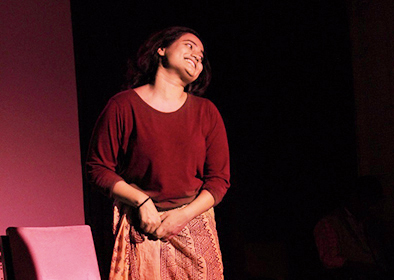Meyeder Khela, a solo-act designed and performed by Satakshi Nandy, marks a significant addition to the body of performances like Shaoli Mitra’s Nathabati Anathabat, Maya Rao’s Walk and so on. The performance punctures the essential ways of ‘seeing’ through the male gaze. Nandy reclaims the space humour, often denied to women, to burst the bubble around toxic hyper-masculinity.
Meyeder Khela presents a bouquet of incidents that happen to Mamoni (the central character), while she strives to become a performer. The narrative makes inroads into the stories of different characters from across the social strata who criss-cross Mamoni’s path. While the vignettes overlap, they can be peeled off to reveal the complex ways in which gaslighting is enabled by the ones who hold power — cultural, economic or social. In the opening sequence, Mamoni, who does not subscribe to the popular male gaze, is pitted against the stereotype of a celebrated hero. Her sincere efforts, trials and failures make the privileges enjoyed by exaggerated masculinity seem ridiculous.
Satakshi carefully draws upon certain mannerisms and body languages to frame each character she introduces. She moves effortlessly from one character to another without loosening her grip on humour. The piece is textured by a smart weave of verbal and physical acting. It opens up possibilities of finding a new vocabulary for the gendered body of a performer steeped in the alphabets of martial arts, boxing, movement and theatre training.
Some choreographic patterns and symbolic phrases are deliberately repeated throughout the performance to build the theme of gaslighting into the form. A few of these instances, if moderately used, will make the piece more crisp. The fragments are communicated in a way that the audience is encouraged to be sensitive to the theme rather than look for causal connections between the stories. Yet, the episode around the woman who is a domestic worker, hangs loose from the larger framework of the script. Meyeder Khela is worthy of attention because it relies on a bold performance language to unpack how violation of consent is not only based on gender, but also on class, religion and social position.










